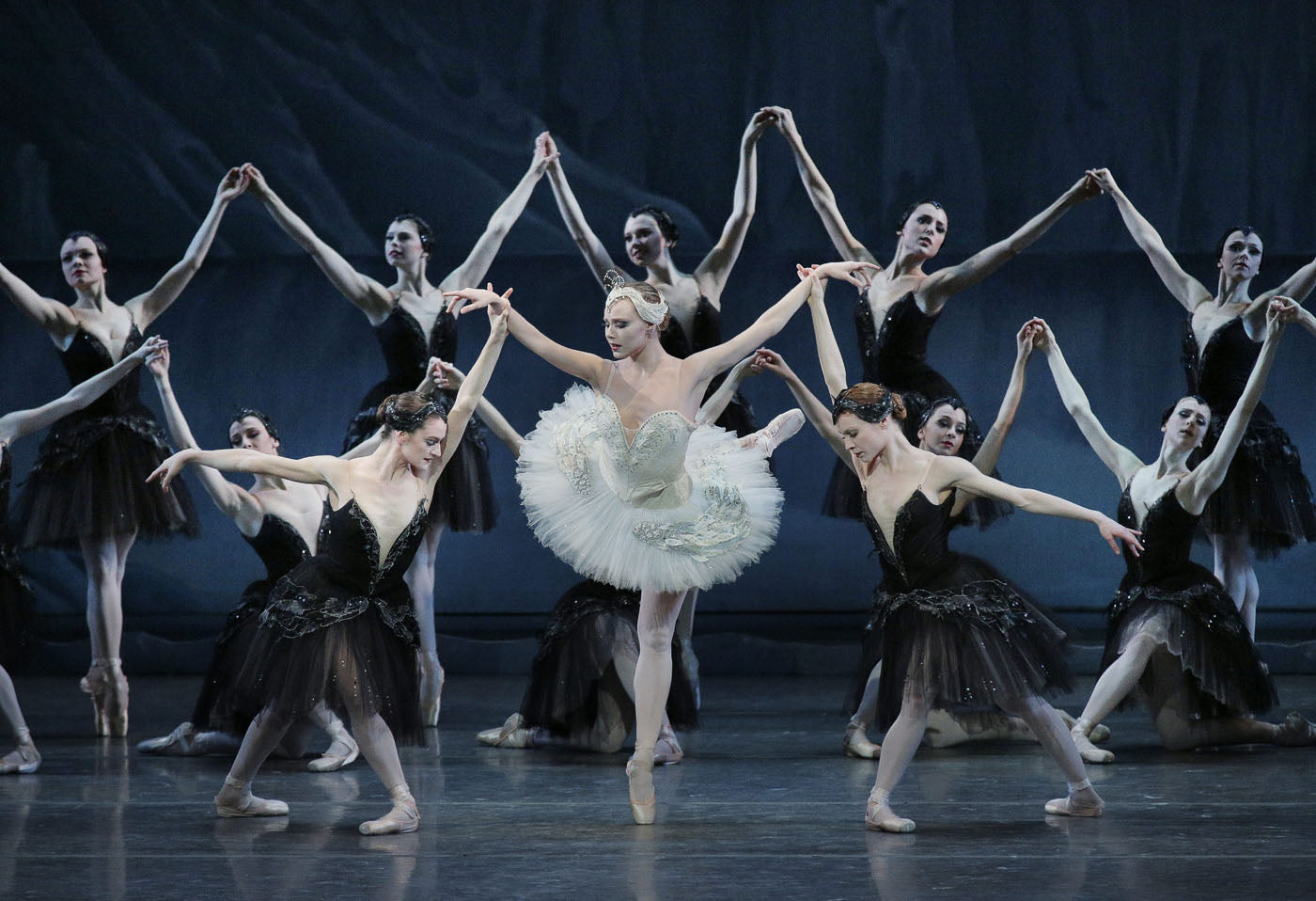“Allegro Brillante” is exactly what its title promises: brilliant allegro dancing. At once playful and formal, lyrical and propulsive, the choreography rides the waves of Tchaikovsky’s Piano Concerto No. 3 with an iridescent spark. Balanchine described this piece as “a concentrated essay in the extended classical vocabulary.” Indeed, “Allegro Brillante” is a 15-minute showcase of classical ballet idiom at its most invigorating.
Responding to the triumphant sounds of the concerto’s opening theme, the four supporting couples are soaring onstage in a circular motion even before the curtain goes up, their fast pirouettes, spurring jumps and soaring lifts vibrant and light. In the course of the ballet, the intricate formations of the ensemble are constantly framing or intertwined with the dancing of the leads. The choreography brilliantly echoes the sweeping dynamics of the music and the dancing seems to never stop. The imagery onstage is breathtaking, exhilarating.
Balancing daring and romantic lyricism, Sara Mearns put her own unmistakable stamp on the principal ballerina role. Although exuberance was the key to her performance, she managed to infuse her dancing with a unique romantic fervor, showing again and again that even bravura steps can be rendered with poignancy and emotional meaning. A showstopper in its own right, her solo variation, accompanied by the turbulent piano cadenza, was exquisitely phrased and delivered with a particular dramatic force. In one memorable scene, as she whirled across the stage in a cascade of spiraling turns, her cavalier (the suave and impeccably gallant Tyler Angle) looked at her with astonishment, remaining motionless as if mesmerized by sheer intensity of her dancing.
When George Balanchine was pressed with the task of creating “Swan Lake” for New York City Ballet, he made it absolutely clear that his version would be his personal interpretation of the classic—a tribute to Tchaikovsky rather than an attempt at “authentic archeological reconstruction.” In his 30-minute long abbreviation of the traditional four-act staging, Balanchine distilled the very essence of the famous 19th-century ballet: the tragic love story between Prince Siegfried and a young princess, Odette, transformed into a swan by the evil sorcerer Von Rotbart.
Taking cues from the 1895 choreography by Lev Ivanov for lakeside acts and staying true to the atmosphere and purpose of the original “Swan Lake,” Balanchine created a suite of pure dances, where emotions are conveyed through movement rather than pantomime. In his staging, the choreographer eliminated the minor characters. Gone are the pesky Jester, the hapless old tutor, and the bossy Queen Mother; and there are no national dances of would-be brides. But most importantly, the choreographer suppressed the character of Odile, the devious double of Odette, who appears as the Black Swan at the royal ball to seduce the prince in the original version of the ballet.
Over the years, Balanchine’s original production has undergone a number of revisions and transformations. The current version features the scenic designs by Alain Vaes, who placed the story in a winter wonderland (the stage evokes a frozen lake, framed by a crown of glistening icicles) and dressed the corps of swans in black tutus, with only Odette, Queen of the Swans, wearing traditional white.
It was impossible not to fall under the spell of Teresa Reichlen’s Odette. She portrayed her heroine as a proud and regal creature—a royal princess, who takes her tragic predicament in stride. Her Odette is no desperate soul. In her exquisitely-rendered movements one could sense her hunger for life and love. With her phenomenally long, supple limbs and her delicate features, Reichlen was destined to dance this role. Her every pose, every plunging arabesque was an extraordinary sight, her beautiful legato phrasing in the adagio awe-inspiring. She created high drama by the sheer beauty of her dancing, which illuminated her love story and made the entire ballet so compelling. Tall and handsome, Russell Janzen looked the part of the Prince. He has a long classical line and his technique is quiet admirable. Yet his dancing felt somewhat dull, and his characterization didn’t leave much of impression.
A seminal work on many levels, “The Four Temperaments” concluded this superb program with a wonderful flair. Created to a commissioned score by Paul Hindemith, this stark, plotless piece, with Balanchine’s choreographic imagery of bent arms and knees, flexed feet, drooping backs, angular torsos and thrusting pelvises, still looks as radical and intriguing as it did when the ballet first premiered more than 70 years ago.
The evening’s cast gave a heroic, spirited rendition of the piece. In the principal roles, Anthony Huxley and Ashley Bouder particularly excelled. An amazingly lissome dancer, Huxley invested the Melancholic variation with great variety of accents, his deep arching backbends vividly expressing his character’s hopelessness and anguish. Fiercely cutting her way through space, the lively Bouder seemed natural for the role of a fearless, exultant Choleric. She looked nothing less than victorious as the leader of the entire ensemble in the ballet’s triumphant, exhilarating finale.




comments